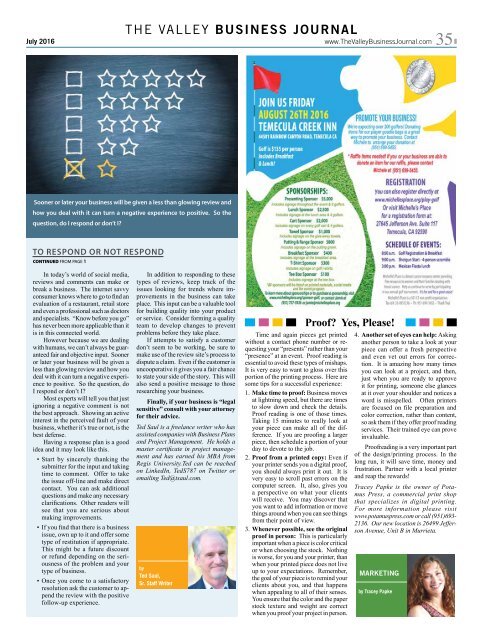July 2016
You also want an ePaper? Increase the reach of your titles
YUMPU automatically turns print PDFs into web optimized ePapers that Google loves.
<strong>July</strong> <strong>2016</strong><br />
THE VALLEY BUSINESS JOURNAL<br />
www.TheValleyBusinessJournal.com<br />
35<br />
Sooner or later your business will be given a less than glowing review and<br />
how you deal with it can turn a negative experience to positive. So the<br />
question, do I respond or don’t I?<br />
To Respond or Not Respond<br />
CONTINUED FROM PAGE 1<br />
In today’s world of social media,<br />
reviews and comments can make or<br />
break a business. The internet savvy<br />
consumer knows where to go to find an<br />
evaluation of a restaurant, retail store<br />
and even a professional such as doctors<br />
and specialists. “Know before you go”<br />
has never been more applicable than it<br />
is in this connected world.<br />
However because we are dealing<br />
with humans, we can’t always be guaranteed<br />
fair and objective input. Sooner<br />
or later your business will be given a<br />
less than glowing review and how you<br />
deal with it can turn a negative experience<br />
to positive. So the question, do<br />
I respond or don’t I?<br />
Most experts will tell you that just<br />
ignoring a negative comment is not<br />
the best approach. Showing an active<br />
interest in the perceived fault of your<br />
business, whether it’s true or not, is the<br />
best defense.<br />
Having a response plan is a good<br />
idea and it may look like this.<br />
• Start by sincerely thanking the<br />
submitter for the input and taking<br />
time to comment. Offer to take<br />
the issue off-line and make direct<br />
contact. You can ask additional<br />
questions and make any necessary<br />
clarifications. Other readers will<br />
see that you are serious about<br />
making improvements.<br />
• If you find that there is a business<br />
issue, own up to it and offer some<br />
type of restitution if appropriate.<br />
This might be a future discount<br />
or refund depending on the seriousness<br />
of the problem and your<br />
type of business.<br />
• Once you come to a satisfactory<br />
resolution ask the customer to append<br />
the review with the positive<br />
follow-up experience.<br />
In addition to responding to these<br />
types of reviews, keep track of the<br />
issues looking for trends where improvements<br />
in the business can take<br />
place. This input can be a valuable tool<br />
for building quality into your product<br />
or service. Consider forming a quality<br />
team to develop changes to prevent<br />
problems before they take place.<br />
If attempts to satisfy a customer<br />
don’t seem to be working, be sure to<br />
make use of the review site’s process to<br />
dispute a claim. Even if the customer is<br />
uncooperative it gives you a fair chance<br />
to state your side of the story. This will<br />
also send a positive message to those<br />
researching your business.<br />
Finally, if your business is “legal<br />
sensitive” consult with your attorney<br />
for their advice.<br />
Ted Saul is a freelance writer who has<br />
assisted companies with Business Plans<br />
and Project Management. He holds a<br />
master certificate in project management<br />
and has earned his MBA from<br />
Regis University.Ted can be reached<br />
on LinkedIn, TedS787 on Twitter or<br />
emailing Ted@tsaul.com.<br />
by<br />
by<br />
Ted Saul,<br />
Steve Fillingim<br />
Sr. Staff Writer<br />
Time and again pieces get printed<br />
without a contact phone number or requesting<br />
your “presents” rather than your<br />
“presence” at an event. Proof reading is<br />
essential to avoid these types of mishaps.<br />
It is very easy to want to gloss over this<br />
portion of the printing process. Here are<br />
some tips for a successful experience:<br />
1. Make time to proof: Business moves<br />
at lightning speed, but there are times<br />
to slow down and check the details.<br />
Proof reading is one of those times.<br />
Taking 15 minutes to really look at<br />
your piece can make all of the difference.<br />
If you are proofing a larger<br />
piece, then schedule a portion of your<br />
day to devote to the job.<br />
2. Proof from a printed copy: Even if<br />
your printer sends you a digital proof,<br />
you should always print it out. It is<br />
very easy to scroll past errors on the<br />
computer screen. It, also, gives you<br />
a perspective on what your clients<br />
will receive. You may discover that<br />
you want to add information or move<br />
things around when you can see things<br />
from their point of view.<br />
3. Whenever possible, see the original<br />
proof in person: This is particularly<br />
important when a piece is color critical<br />
or when choosing the stock. Nothing<br />
is worse, for you and your printer, than<br />
when your printed piece does not live<br />
up to your expectations. Remember,<br />
the goal of your piece is to remind your<br />
clients about you, and that happens<br />
when appealing to all of their senses.<br />
You ensure that the color and the paper<br />
stock texture and weight are correct<br />
when you proof your project in person.<br />
Proof? Yes, Please!<br />
4. Another set of eyes can help: Asking<br />
another person to take a look at your<br />
piece can offer a fresh perspective<br />
and even vet out errors for correction.<br />
It is amazing how many times<br />
you can look at a project, and then,<br />
just when you are ready to approve<br />
it for printing, someone else glances<br />
at it over your shoulder and notices a<br />
word is misspelled. Often printers<br />
are focused on file preparation and<br />
color correction, rather than content,<br />
so ask them if they offer proof reading<br />
services. Their trained eye can prove<br />
invaluable.<br />
Proofreading is a very important part<br />
of the design/printing process. In the<br />
long run, it will save time, money and<br />
frustration. Partner with a local printer<br />
and reap the rewards!<br />
Tracey Papke is the owner of Potamus<br />
Press, a commercial print shop<br />
that specializes in digital printing.<br />
For more information please visit<br />
www.potamuspress.com or call (951)693-<br />
2136. Our new location is 26499 Jefferson<br />
Avenue, Unit B in Murrieta.<br />
MARKETING<br />
by Tracey Papke

















